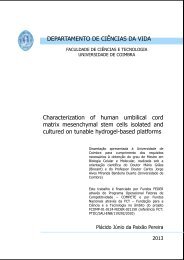Regulation of Apoptosis and Differentiation by p53 in Human ...
Regulation of Apoptosis and Differentiation by p53 in Human ...
Regulation of Apoptosis and Differentiation by p53 in Human ...
You also want an ePaper? Increase the reach of your titles
YUMPU automatically turns print PDFs into web optimized ePapers that Google loves.
CHAPTER 1: Introduction<br />
1.1.4.2- FGF-2<br />
FGF-2, also known as basic fibroblast growth factor (bFGF), is a member <strong>of</strong> a family <strong>of</strong> over 20<br />
polypeptide growth factors (Ornitz <strong>and</strong> Itoh, 2001) FGFs are found <strong>in</strong> different species rang<strong>in</strong>g<br />
from nematodes to humans. The recomb<strong>in</strong>ant FGF-2 is a 16.5-kDa peptide with 144 am<strong>in</strong>o acids<br />
(Okada-Ban et al., 2000). The biologic activity <strong>of</strong> FGF-2 is mediated <strong>by</strong> four related<br />
transmembrane tyros<strong>in</strong>e k<strong>in</strong>ase receptors: FGFR-1, -2, -3, <strong>and</strong> -4, <strong>and</strong> possibly other<br />
transmembrane receptors (Powers et al., 2000; Khurana <strong>and</strong> Simons, 2003). Lig<strong>and</strong> b<strong>in</strong>d<strong>in</strong>g<br />
results <strong>in</strong> homodimerization <strong>of</strong> these receptors, trans-phosphorylation <strong>and</strong> signal transduction.<br />
Numerous splice variants <strong>of</strong> multiple genes generate a wide diversity <strong>of</strong> FGFRs. FGF-2 has a<br />
pleiotropic effect on different types <strong>of</strong> cells <strong>and</strong> its cellular response can be affected <strong>by</strong> type <strong>of</strong><br />
receptor b<strong>in</strong>d<strong>in</strong>g, rate <strong>of</strong> <strong>in</strong>tracellular growth factor uptake <strong>and</strong> <strong>in</strong>teract<strong>in</strong>g molecules <strong>in</strong>side the<br />
cell (Goldfarb, 2001). FGF-2 can act as a survival factor <strong>by</strong> block<strong>in</strong>g apoptosis (Fisher, 1997;<br />
Stachowiak et al., 1997), it also stimulates angiogenesis (Slav<strong>in</strong>, 1995; Bikfalvi, 1995) <strong>and</strong> cell<br />
proliferation via activation <strong>of</strong> the Ras/Raf-MAPK pathway <strong>by</strong> enabl<strong>in</strong>g adaptor prote<strong>in</strong>s Grb2, Shc,<br />
<strong>and</strong> Nck to participate <strong>in</strong> signal transduction cascades (Kle<strong>in</strong> <strong>and</strong> Schneider, 1997). It can also<br />
promote tumor progression (Bikfalvi, 1995; Vacca et al., 2001). FGF-2 was been used <strong>in</strong> hESC<br />
culture (Xu et al., 2001; Amit et al., 2004) <strong>in</strong> serum- <strong>and</strong> feeder-free culture methods because it<br />
<strong>in</strong>hibits hESC differentiation. Two studies were published that show that higher doses <strong>of</strong> FGF-2<br />
(100 <strong>and</strong> 40 ng/ml) override the requirement for MEF feeders or its conditioned medium on<br />
ma<strong>in</strong>tenance <strong>of</strong> hESC <strong>and</strong> this effect is mediated <strong>by</strong> the <strong>in</strong>hibition <strong>of</strong> BMP signal<strong>in</strong>g (Xu et al.,<br />
2005a; Xu et al., 2005b; Levenste<strong>in</strong> et al., 2006).<br />
Bendall <strong>and</strong> colleagues have found that under feeder-free culture conditions, the hESC organize<br />
themselves <strong>in</strong> order to create a niche <strong>in</strong> which derived hESC derived fibroblast-like cells are<br />
dependent on FGF-2 <strong>and</strong> <strong>in</strong> response to this factor express IGF-1 reported to promote selfrenewal<br />
<strong>of</strong> undifferentiated hESC (Bendall et al., 2007).<br />
1.1.4.3- Transform<strong>in</strong>g growth factor β (TGFβ) pathway<br />
TGFβ superfamily members play an important role <strong>in</strong> a wide range <strong>of</strong> cellular processes <strong>in</strong>clud<strong>in</strong>g<br />
tissue differentiation, morphogenesis, proliferation, migration <strong>and</strong> apoptosis <strong>in</strong> embryonic<br />
development, as well <strong>in</strong> adult homeostasis <strong>and</strong> response to disease <strong>and</strong> <strong>in</strong>jury (Massague, 1990).<br />
The TGFβ superfamily <strong>of</strong> lig<strong>and</strong>s <strong>in</strong>clude TGFβ, Activ<strong>in</strong>, Nodal, Bone morphogenetic prote<strong>in</strong>s<br />
(BMP) <strong>and</strong> Growth/<strong>Differentiation</strong> factors (GDF), among others. All <strong>of</strong> these have been<br />
associated with ESC (Valdimarsdottir <strong>and</strong> Mummery, 2005). These lig<strong>and</strong>s b<strong>in</strong>d to heteromeric<br />
complex <strong>of</strong> ser<strong>in</strong>e/threon<strong>in</strong>e k<strong>in</strong>ase receptors called TGFβ type I <strong>and</strong> type II receptors. The type I<br />
receptor acts downstream <strong>of</strong> the type II receptor <strong>and</strong> transduces the signal through the<br />
phosphorylation <strong>of</strong> Smads (Massague, 2000; Piek et al., 1999), wich play theirs role <strong>in</strong> the<br />
nucleus act<strong>in</strong>g as transcription factors or target genes.<br />
It has been shown that ma<strong>in</strong>tenance <strong>of</strong> hESC <strong>in</strong> an undifferentiated state requires the action <strong>of</strong><br />
the TGFβ/Nodal/Activ<strong>in</strong> branch <strong>of</strong> the TGFβ superfamily (Amit et al., 2004; Ludwig et al., 2006b;<br />
Vallier et al., 2005; Vallier et al., 2004). It has been suggested that TGFβ1 prevents differentiation<br />
- 10 -
















